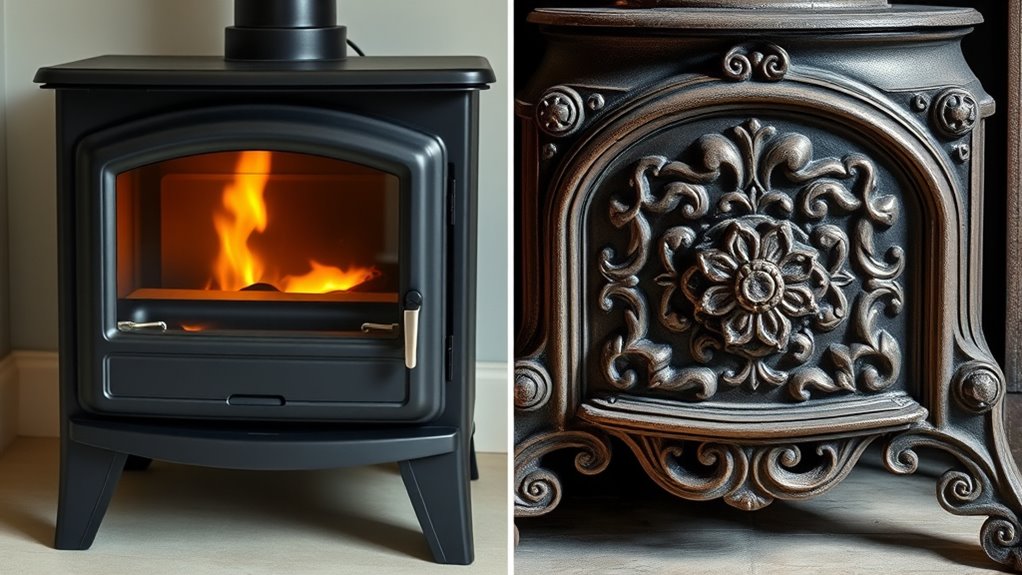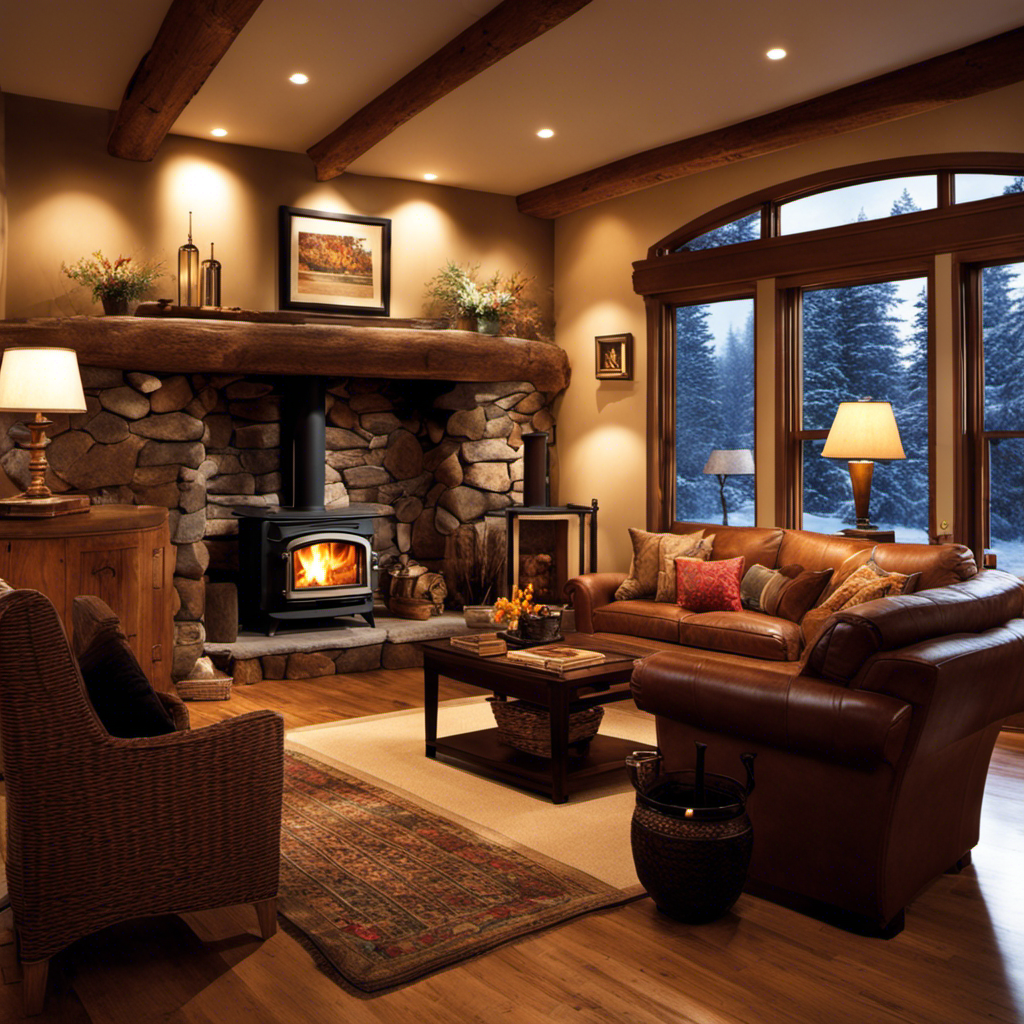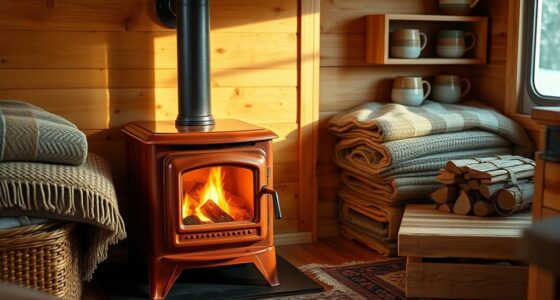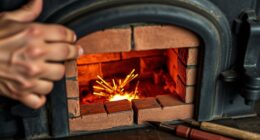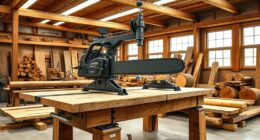When choosing between steel and cast iron wood stoves, consider durability, heat retention, and style. Steel stoves are lightweight, easy to maintain, and modern in appearance, but they cool faster and may need more attention. Cast iron offers excellent heat retention, traditional charm, and long-lasting strength but is heavier and requires more upkeep. To understand which suits your needs better and discover key benefits, explore this comparison further.
Key Takeaways
- Steel stoves are lightweight, resistant to rust, and easier to maintain, making them ideal for outdoor or modern settings.
- Cast iron stoves offer superior heat retention, even heat distribution, and a classic aesthetic suited for indoor decorative use.
- Steel models generally cost less upfront and require less frequent maintenance, while cast iron stoves are more durable but more expensive initially.
- Cast iron’s thick material provides excellent safety and longevity, whereas steel heats quickly but cools faster, needing more tending.
- Design options differ: cast iron offers vintage, ornate styles, while steel allows sleek, modern, and customizable finishes.
Material Composition and Manufacturing Processes
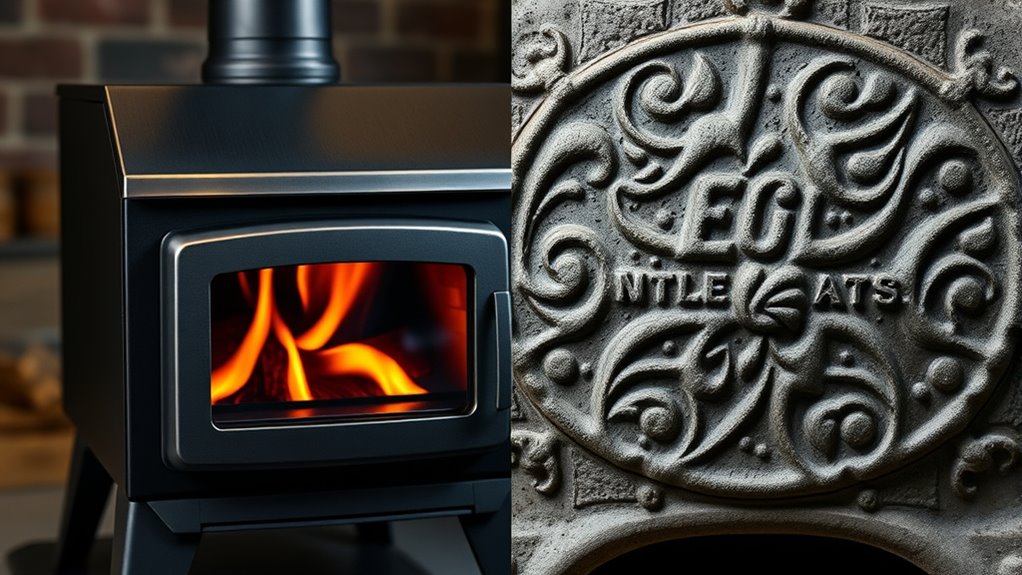
Steel and cast iron stoves differ markedly in their material composition and manufacturing processes. Steel stoves are made from a blend of iron and carbon, resulting in a lighter, more flexible metal. Their manufacturing techniques often involve rolling or stamping sheets of steel into the desired shape, then welding or assembling the parts. Cast iron stoves, on the other hand, are created by pouring molten iron into molds, which produces a dense, heavy metal piece. This casting process allows for intricate designs and thicker walls. The metal composition of cast iron grants it high heat retention, while steel’s manufacturing techniques produce a more lightweight, adaptable stove. Understanding these differences helps you appreciate how each stove’s construction influences its performance and characteristics. Additionally, metal durability plays a significant role in the long-term maintenance and safety of these stoves, and the thermal mass of cast iron contributes to its ability to retain and radiate heat over extended periods. Moreover, manufacturing techniques impact not only the aesthetics but also the overall strength and longevity of the stove.
Durability and Longevity
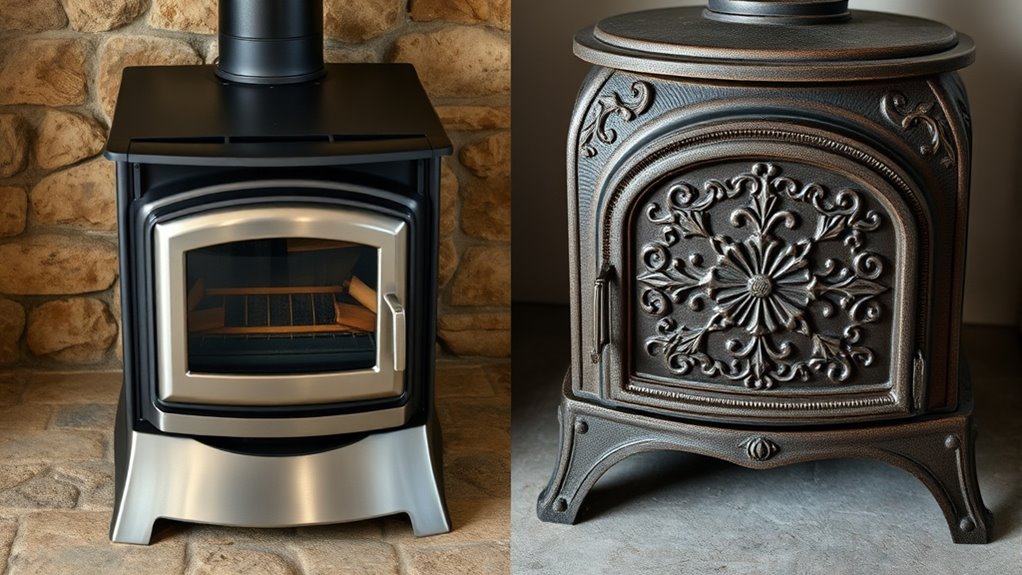
When it comes to durability and longevity, cast iron stoves are renowned for their exceptional resilience, often lasting for decades with proper care. They excel in crack resistance, maintaining structural integrity over time. Their rust resistance varies, but applying a protective coating can extend their lifespan. Steel stoves are also durable but may require more maintenance to prevent rust. Here’s a quick comparison:
| Feature | Cast Iron | Steel |
|---|---|---|
| Crack Resistance | High | Moderate |
| Rust Resistance | Moderate; needs coating | Better naturally |
| Longevity | Decades with care | 15-20 years achievable |
| Maintenance | Low once seasoned | Regular rust prevention |
| Overall Durability | Excellent for long-term use | Good but shorter lifespan |
Both materials offer durability, but your choice depends on your maintenance willingness and desired longevity. Additionally, proper seasoning and maintenance can significantly enhance the lifespan of cast iron stoves, emphasizing the importance of regular upkeep.
Heat Retention and Distribution
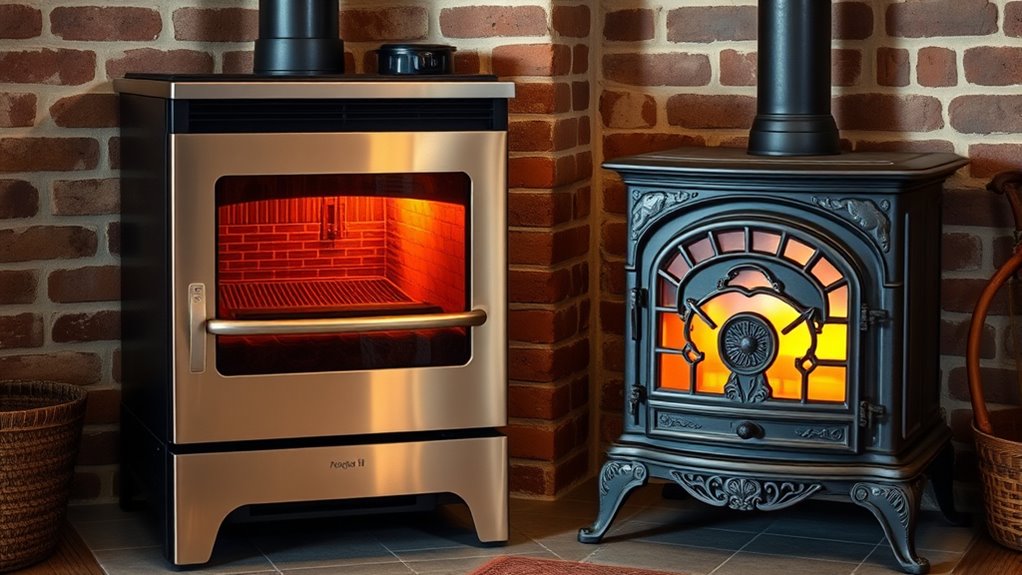
While cast iron stoves are known for their durability, their thick metal construction also makes them excellent at retaining heat. You’ll notice they radiate warmth steadily, helping you feel cozy longer. This heat retention enhances heat efficiency, meaning less wood waste and more comfort. Plus, their ability to hold heat evenly contributes to safer fire safety, reducing the risk of hotspots or accidental flare-ups. Additionally, filter replacement indicators can help ensure proper maintenance and optimal performance over time. Consider these benefits:
Cast iron stoves provide steady warmth, improve efficiency, and enhance safety through even heat retention.
- You enjoy a consistent, comforting heat after the fire’s gone out
- Reduced risk of fire hazards with even heat distribution
- Less frequent refueling saves time and effort
- The drainage system within cast iron stoves helps manage moisture and prolongs their lifespan
- The materials used in cast iron are highly resistant to corrosion and wear, extending their operational life
In contrast, steel stoves heat up quickly but cool down faster, requiring more frequent tending. Cast iron’s superior heat retention makes it a reliable choice for safer, more efficient warmth.
Aesthetic Appeal and Design Options
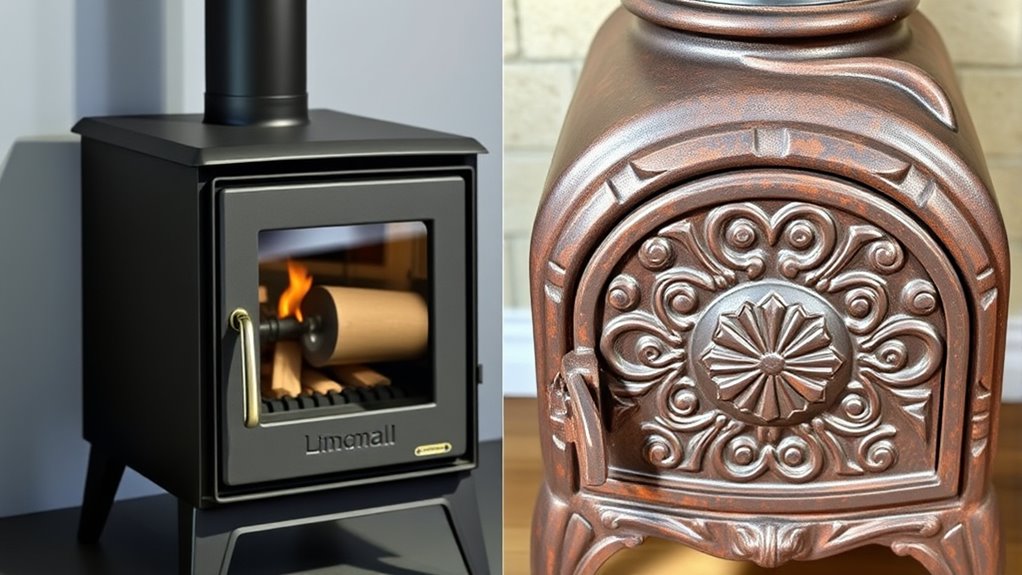
Cast iron stoves often serve as statement pieces in any room, thanks to their classic, timeless appeal. Their ornate designs and sturdy build evoke rustic charm, making them perfect for cozy cabins or country homes. You can choose from vintage-inspired models or more decorative finishes that add character to your space. You can also find a variety of finishes that cater to different interior styles. Steel stoves, on the other hand, offer sleek, modern aesthetics with clean lines and minimalist designs. They blend seamlessly into contemporary interiors, giving your room a streamlined look. Both materials provide a range of options, but your choice ultimately depends on your style preference. Whether you favor the nostalgic warmth of cast iron or the crisp elegance of steel, each material allows you to customize your stove to enhance your home’s visual appeal. Additionally, understanding the aesthetic appeal and design options can help you select a stove that complements your overall decor. For example, considering material durability can ensure your choice withstands the test of time while maintaining its beauty. Exploring the design versatility of each material can further help you choose a stove that fits your specific aesthetic needs.
Ease of Maintenance and Cleaning
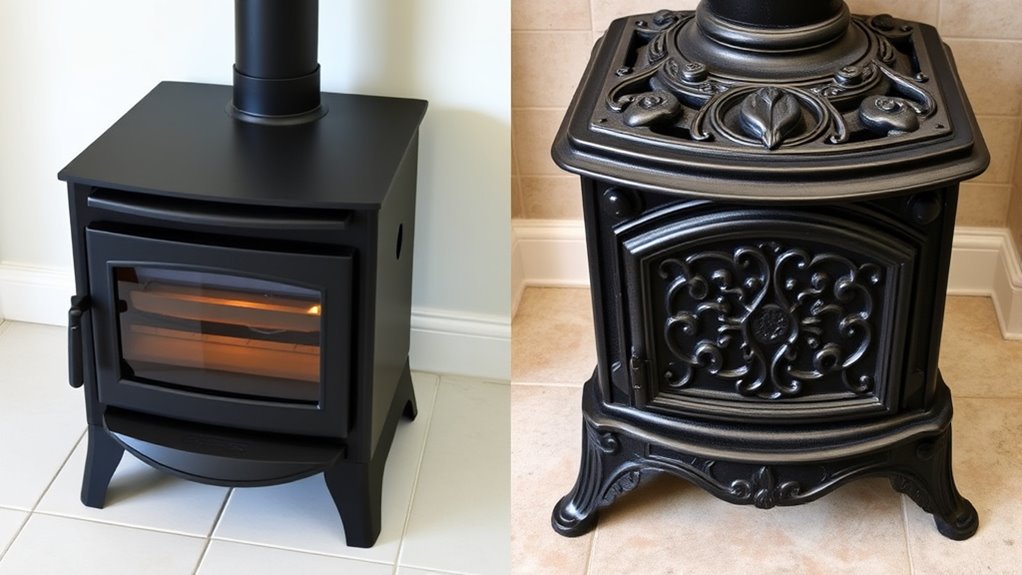
Cleaning your stove should be straightforward, but how easy it is depends on the surface material. Steel stoves typically require less frequent maintenance because of their durable finish, making cleanup simpler. Cast iron stoves may need more regular attention to keep them in top shape, especially due to their porous surface. Additionally, GMC tuning techniques can influence how well your stove remains in optimal condition over time. Incorporating proper skincare routines can also help protect the stove’s surface from damage and wear, ensuring it stays in good condition longer.
Cleaning Procedures Simplicity
When it comes to maintenance, steel stoves are generally easier to keep clean than cast iron models. You’ll find ash removal simpler because steel surfaces resist stubborn buildup, reducing cleanup time. Soot cleaning is also less challenging, as steel’s smooth finish prevents soot from sticking as firmly. Additionally, sound vibrations from certain cleaning tools can help loosen debris more effectively on steel surfaces. Consider these advantages: – Quick, effortless ash removal keeps your stove tidy – Less soot buildup means fewer scrubbing sessions – Cleaning is faster, so you spend more time enjoying your fire Steel stoves’ sleek surface means you won’t struggle with stubborn stains or rust, making routine maintenance a breeze. Moreover, their resistance to corrosion ensures they maintain their appearance and functionality over time, requiring less frequent repairs. Proper material durability also contributes to easier upkeep, as steel is less prone to cracking or warping under thermal stress. Overall, they require less effort to maintain their appearance and function, giving you more peace of mind.
Durability of Surfaces
Steel stoves tend to hold up better over time, making them easier to maintain and clean. Their surface scratch resistance helps keep the exterior looking new longer, resisting marks from regular cleaning or accidental bumps. Additionally, steel’s superior corrosion resistance protects against rust, especially in humid environments, reducing surface deterioration. Regular cleaning with appropriate products can further extend the lifespan of steel surfaces, highlighting their ease of maintenance. For those seeking longevity, steel stoves are often recommended due to their durability of surfaces. The smoother surface also makes cleaning and maintenance more straightforward and less time-consuming. Steel’s ability to support various finishes and coatings can further enhance its surface protection, making it a practical choice for long-term use. Cast iron stoves, while durable, are more prone to chipping and surface scratches, which can lead to rust over time. Here’s a quick comparison:
| Feature | Steel Stove | Cast Iron Stove |
|---|---|---|
| Surface Scratch Resistance | High | Moderate |
| Corrosion Resistance | Excellent | Fair |
| Maintenance Ease | Easier | Slightly more effort |
Maintenance Frequency
Steel stoves generally require less frequent maintenance and are easier to keep pristine compared to cast iron models. You’ll find that burner maintenance is straightforward, thanks to smoother surfaces that resist buildup. Ash removal is quick and less messy, making cleanup less of a chore. With steel, you spend less time cleaning and more time enjoying your fire. Additionally, steel stoves are often equipped with easy cleanup features, which further simplify ongoing maintenance routines. Their corrosion resistance also helps maintain a cleaner appearance over time, reducing the need for frequent repairs or touch-ups. Steel stoves are also less prone to warping and cracking, which ensures long-term durability, and their resistance to rusting helps extend their lifespan, making them a practical choice for many users.
Cost and Affordability
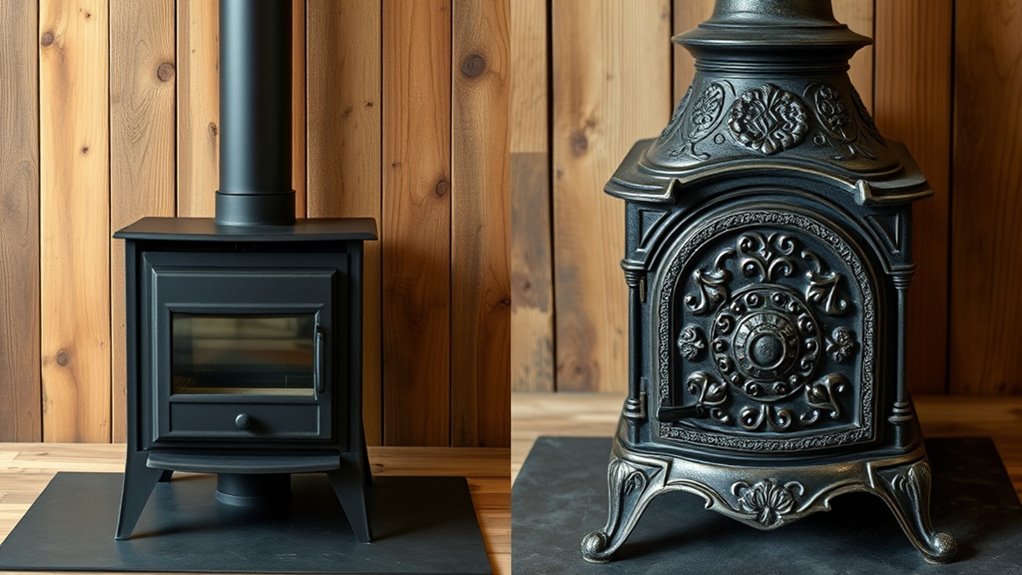
Cast iron stoves typically come with a higher upfront cost compared to steel stoves, but they can offer better long-term value. When considering pricing differences, cast iron models are generally more expensive initially due to their durable material and craftsmanship. However, affordability factors such as longevity and heat retention can make them cost-effective over time. Steel stoves tend to be more budget-friendly upfront, which appeals to those seeking immediate savings. Still, they may require more frequent repairs or replacement, potentially increasing overall costs. Your choice depends on your budget and priorities. If you prioritize durability and long-term savings, investing in a cast iron stove might be worthwhile. Conversely, if upfront affordability is key, a steel stove could be the better option. Additionally, understanding the cybersecurity vulnerabilities associated with digital controls can be important when selecting modern stove models.
Environmental Impact and Sustainability
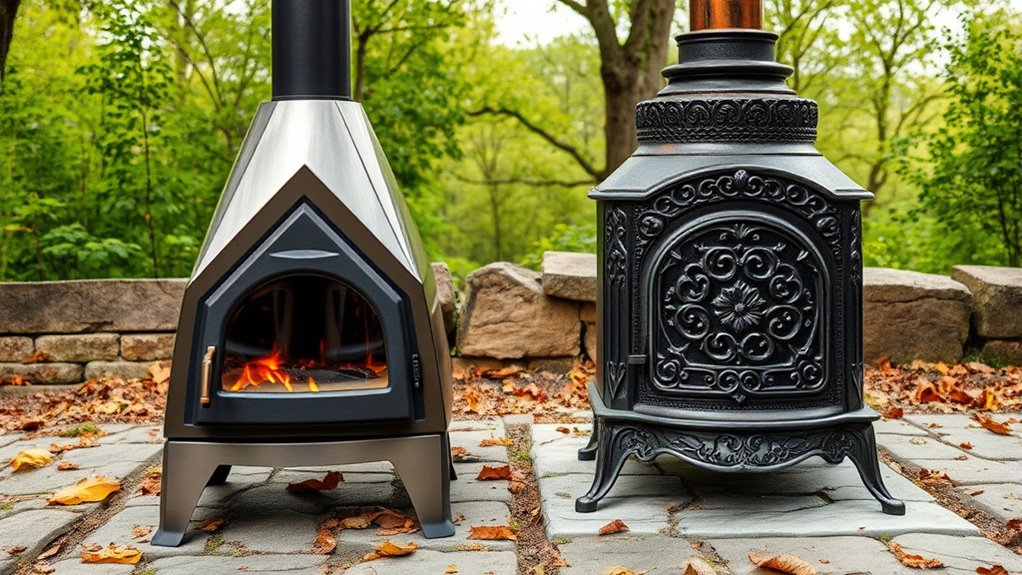
You should consider how each stove type affects air quality through emissions and pollutants. Think about the resources used in manufacturing and how easily the stoves can be recycled or reused. Ultimately, evaluate their overall environmental costs over their entire lifespan to make a sustainable choice.
Emissions and Air Quality
Have you ever wondered how different wood stove materials impact air quality and environmental sustainability? Your choice affects emissions, especially airborne particulates that influence indoor air quality. Steel stoves tend to produce fewer emissions, helping reduce harmful pollutants in your home. Cast iron models, while durable, may emit more particulates due to their heat retention properties. This affects not only your indoor air but also the environment. Consider these impacts:
- Breathing cleaner air that protects your health and reduces respiratory issues.
- Lowering your carbon footprint by choosing a stove with fewer emissions.
- Contributing to a healthier planet by minimizing airborne pollutants and air pollution.
Your decision influences both your home’s air quality and the environment’s sustainability, making it a essential consideration.
Resource Use and Recycling
While both steel and cast iron wood stoves are durable heating options, their resource use and recyclability profoundly impact environmental sustainability. Steel stoves generally have a higher recycling potential due to the widespread availability of scrap steel and its ease of melting and reprocessing. This makes steel more resource-efficient, reducing the need for virgin materials. Cast iron stoves, on the other hand, are often made from recycled iron, but their complex manufacturing process can limit recycling options compared to steel. Both materials can be recycled at the end of their lifespan, minimizing waste. Choosing a stove with high resource efficiency and strong recycling potential helps reduce environmental impact, supporting more sustainable heating solutions for your home and the planet.
Lifecycle Environmental Costs
Both steel and cast iron stoves contribute to environmental impacts over their entire lifespans, from production to disposal. Manufacturing emissions release pollutants, affecting air quality, while the recycling potential of these materials offers hope for sustainability. Your choices can influence the ecological footprint you leave behind. Consider the following:
- Reduced waste: Both metals can be recycled repeatedly, minimizing landfills.
- Lower emissions: Opting for stoves made with eco-friendly processes reduces manufacturing emissions.
- Material longevity: Durable stoves mean fewer replacements and less environmental strain over time.
Safety and Structural Integrity
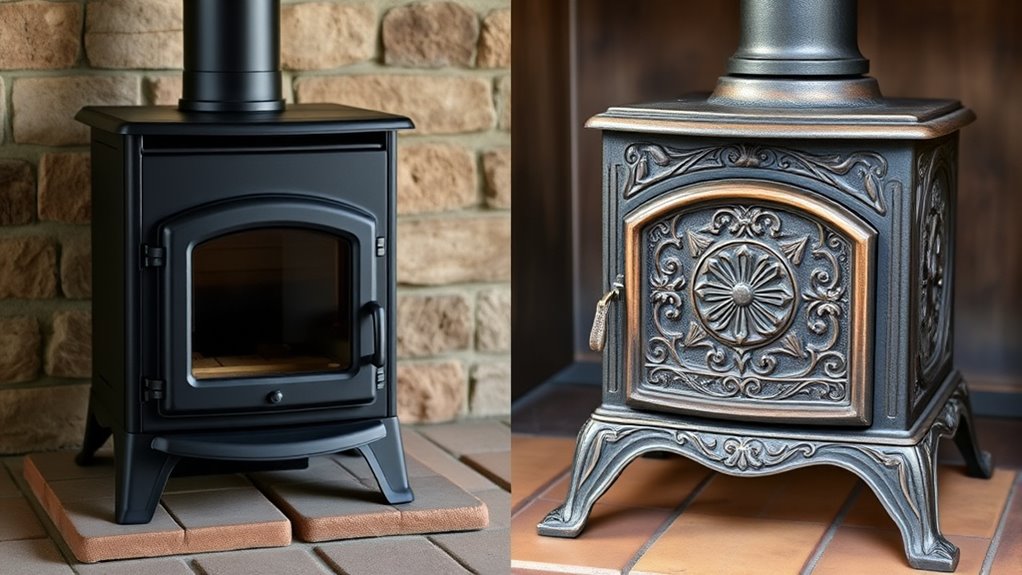
When choosing between steel and cast iron wood stoves, safety and structural integrity are crucial considerations. You need to assess how each material impacts fire hazard and overall durability. Steel stoves generally heat up quickly and cool down faster, reducing the risk of overheating, but their thinner walls can pose a fire hazard if not properly maintained. Cast iron stoves, on the other hand, boast exceptional structural strength, making them less prone to warping or cracking over time. This durability enhances safety by maintaining a stable structure even under high temperatures. Both materials require proper installation and regular inspections to ensure safety, but cast iron’s robustness offers added peace of mind. Prioritizing structural integrity minimizes risks and helps you enjoy your stove safely for years to come.
Ideal Uses and Suitable Environments
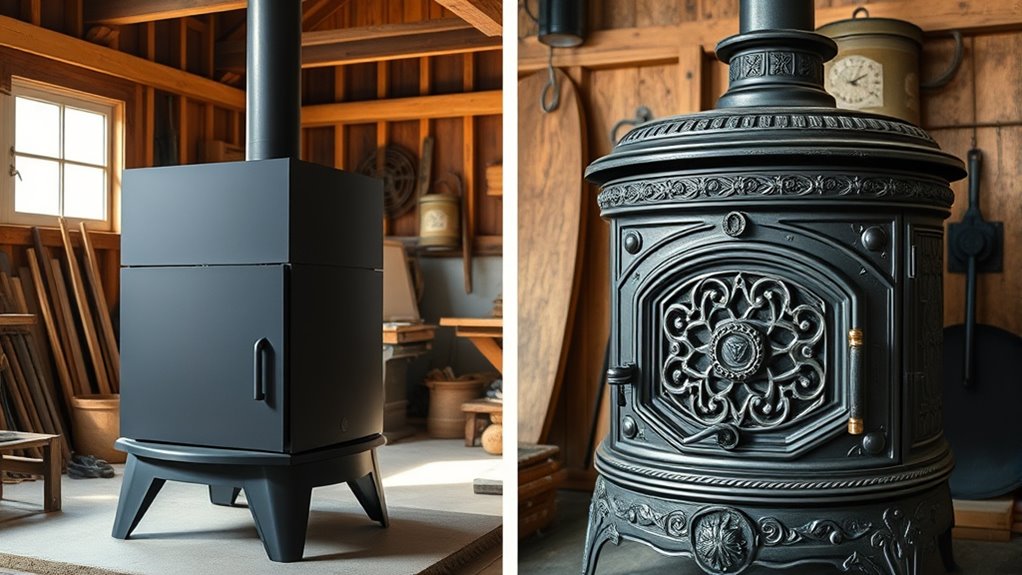
Choosing the right wood stove depends heavily on your specific needs and the environment where it will be used. Steel stoves excel in outdoor installations, offering durability and portability for cabins or outdoor living spaces. Cast iron stoves are perfect for cozy indoor settings, adding a charming, rustic touch with their decorative accents. Consider your space and aesthetic preferences when selecting a stove.
Choosing the right wood stove depends on your needs, space, and style preferences for indoor or outdoor use.
- Create a warm outdoor retreat with a durable, portable steel stove
- Add character and charm to your living room with a cast iron stove’s timeless look
- Enhance your space’s ambiance with decorative accents and thoughtful design
Your ideal stove should match your environment, whether it’s the practicality of outdoor use or the aesthetic appeal of a decorative indoor feature.
Frequently Asked Questions
Which Material Heats up Faster During Initial Use?
When you ask which material heats up faster, steel or cast iron, steel generally wins. Its high thermal conductivity allows it to transfer heat quickly, reducing the wait time. Additionally, steel’s metal expansion means it warms up and cools down faster, making it more responsive initially. So, if you want quicker heating, steel’s your better choice because it heats up faster during initial use due to these properties.
Can These Stoves Be Used Outdoors Effectively?
You can use these stoves outdoors effectively, but you’ll need to take into account outdoor installation and weatherproofing considerations. Make certain your stove is placed on a stable, non-combustible surface, and protect it from rain and snow with a suitable cover. For long-term outdoor use, opt for models designed with weather-resistant materials or add weatherproofing measures. Proper setup helps your stove perform well and last longer in outdoor environments.
How Do They Perform in Extremely Cold Climates?
Did you know that wood stoves can heat spaces up to 1,000 square feet? In extremely cold climates, your choice matters. Steel stoves heat quickly but may need more frequent burns, while cast iron retains heat longer. Make certain your stove’s thermostat compatibility and installation requirements are suited for harsh conditions. Proper insulation and a sturdy setup are essential for effective heating during frigid winters.
Are There Health Concerns Associated With Emissions?
You might wonder if emissions from wood stoves pose health risks. Emissions can impact air quality, especially if your stove isn’t well-maintained. To protect your health, verify your stove meets current emission standards and uses properly seasoned wood. Regular cleaning reduces harmful smoke and particulate matter. By following these steps, you minimize potential health concerns and help maintain better air quality in your home.
Which Material Is More Resistant to Cracking or Warping?
In the grand scheme of things, you’ll find that cast iron generally offers better crack resistance due to its lower thermal expansion rate. While steel can withstand high temperatures, it’s more prone to warping or cracking under rapid temperature changes. So, if durability against cracking or warping matters most, cast iron is your best bet, providing superior resistance and longevity in the face of thermal stresses.
Conclusion
Choosing between steel and cast iron stoves is like picking a trusted companion—each offers unique strengths. Steel’s sleekness and speed or cast iron’s timeless durability can transform your space. Remember, your choice shapes more than warmth; it defines your home’s character. So, which will you invite into your sanctuary? The answer lies in what matters most to you—performance, style, or sustainability. Make your decision wisely, for your stove’s legacy begins with it.

